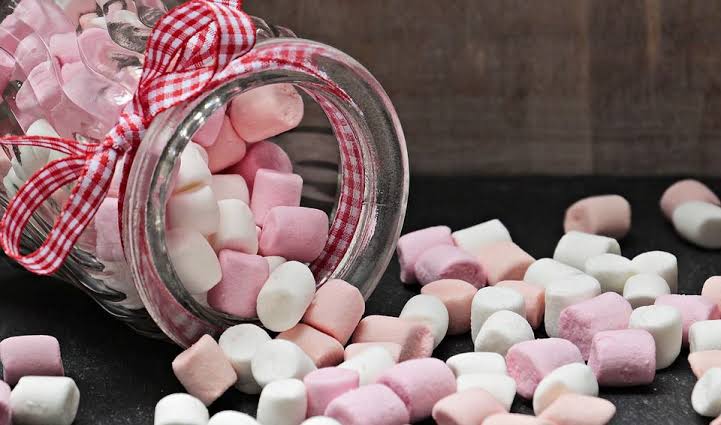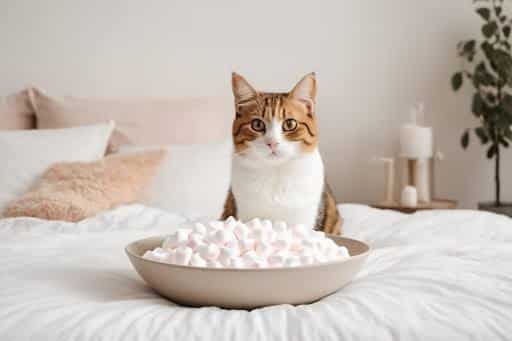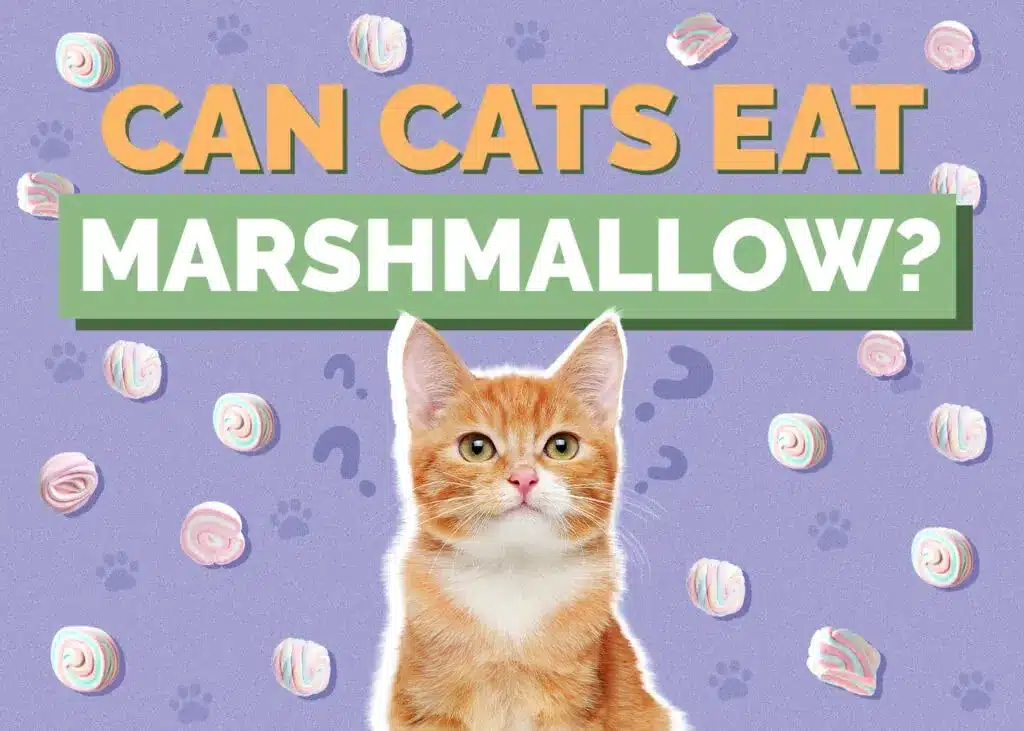We, as pet owners, can attest to the fact that our cats like to nibble on houseplants and our snacks. This makes us to wonder about the safety of various foods. However, our attention will focus on marshmallows and its safety to cats. Hence, the question “Can Cats Eat Marshmallows?”. Let’s proceed to uncover that mystery.
What Are Marshmallows?
Marshmallows are a type of sweet treat that stood the test of time. Traditionally, marshmallows come from the sap of the marshmallow plant (Althaea officinalis), which grows in marshes and other damp areas. The sap (mucilage, came from the plant’s roots and whipped with sugar and egg whites to create a soft, spongy candy.
However, modern marshmallows come from a combination of sugar, water, gelatin, and corn syrup. These ingredients undergo heating and whipping to create the fluffy texture that marshmallows are known for. The gelatin serves as a stabilizer, giving marshmallows their characteristic bounce and chewiness.
Ingredients:
- Sugar: Provides sweetness and contributes to the structure of the marshmallow.
- Water: Helps dissolve the sugar and create the syrupy base for the marshmallow mixture.
- Gelatin: Acts as a thickening agent and provides the marshmallow’s signature texture.
- Corn Syrup: Adds sweetness and helps prevent the formation of sugar crystals.
- Flavorings: While traditional marshmallows were often flavored with vanilla, modern versions can come in a variety of flavors, including strawberry, chocolate, and peppermint.
Production Process:
- Mixing: The sugar, water, and corn syrup are combined in a large pot and heated until the sugar is dissolved, creating a syrupy mixture.
- Adding Gelatin: Gelatin is then added to the syrup and allowed to dissolve, creating a thick, sticky liquid.
- Whipping: The mixture is then whipped at high speed until it becomes light and fluffy. This process incorporates air into the marshmallow, giving it its characteristic texture.
- Setting: Once whipped, the marshmallow mixture is poured into molds and allowed to set for several hours or overnight.
- Cutting: Once set, the marshmallow is removed from the molds and cut into individual pieces. Some marshmallows may also be coated in powdered sugar or cornstarch to prevent sticking.
Recommended: Can Cats Eat Chocolate?

Understanding Cats’ Digestive Systems
It is crucial to know cats’ digestive systems to enable cat owners ensure their health and well-being. Let’s explore the intricacies of cats’ digestive systems in detail.
Anatomy Of A Cat’s Digestive System
- Mouth and Teeth: Cats have sharp, pointed teeth designed for tearing meat. Their saliva contains enzymes that begin the breakdown of food.
- Esophagus: This muscular tube carries food from the mouth to the stomach through a process called peristalsis, which involves rhythmic contractions.
- Stomach: The stomach of a cat is highly acidic, aiding in the digestion of protein-rich foods. It also contains enzymes and gastric juices that further break down food.
- Small Intestine: Here, nutrients from digested food are absorbed into the bloodstream. The small intestine is lined with villi, tiny finger-like projections that increase its surface area for efficient nutrient absorption.
- Large Intestine: This is where water is absorbed from the remaining food matter, forming feces. The large intestine also houses beneficial bacteria that aid in digestion.
Dietary Needs Of Cats
- Carnivorous Diet: Cats are obligate carnivores, meaning they require a diet rich in animal protein to thrive. Their bodies are adapted to digest and absorb nutrients from animal-based sources efficiently.
- Water Intake: Cats have a relatively low thirst drive compared to other animals. Feeding wet food or providing a water fountain can help ensure they stay adequately hydrated.
- Taurine Requirement: Taurine is an essential amino acid for cats, crucial for maintaining heart and eye health. Commercial cat foods are fortified with taurine to meet this dietary need.
Common Digestive Issues
- Gastrointestinal Upsets: Cats may experience diarrhea, vomiting, or constipation due to dietary indiscretion, food allergies, or gastrointestinal infections. It’s essential to monitor their stool quality and seek veterinary attention if digestive issues persist.
- Inflammatory Bowel Disease (IBD): This condition involves chronic inflammation of the digestive tract, leading to symptoms such as diarrhea, vomiting, and weight loss. Treatment often involves dietary management and medication prescribed by a veterinarian.
Dangers Of Feeding Marshmallows To Your Cats
While marshmallows may seem harmless and delicious to us, they can pose serious risks to our beloved feline friends. Here are the various dangers associated with feeding marshmallows to cats and why it’s crucial to avoid doing so.
1. High Sugar Content
Cats lack the necessary enzymes to properly digest and metabolize sugar, leading to potential health issues such as obesity, diabetes, and dental problems. Feeding marshmallows to cats can contribute to weight gain and increase the risk of developing diabetes, especially in overweight or senior cats.
2. Artificial Ingredients
These additives may cause gastrointestinal upset, allergic reactions, or even toxic effects in sensitive individuals. Cats are particularly sensitive to certain food additives, and consuming marshmallows with artificial ingredients can lead to digestive issues such as vomiting, diarrhea, or abdominal pain.
3. Choking Hazard
The soft, squishy texture of marshmallows can pose a choking hazard to cats, especially if they try to swallow them whole. Cats lack the molars necessary to chew food thoroughly, increasing the risk of large pieces of marshmallow becoming lodged in their throat or gastrointestinal tract.
4. Xylitol Poisoning
Some marshmallow brands may contain xylitol, a sugar substitute commonly used in sugar-free products. Xylitol is highly toxic to cats and can cause a rapid increase in insulin levels, leading to hypoglycemia (low blood sugar) and liver failure. Even small amounts of xylitol can be fatal to cats, making it crucial to check the ingredients list of marshmallows and other products before offering them to your feline friend.
Recommended: Can Cats Eat Bananas?

Alternatives To Marshmallows For Treating Cats
While marshmallows may be off the menu for cats due to their potential risks, there are plenty of other tasty treats that you can offer your feline companion. Let’s explore some cat-safe alternatives to marshmallows that will satisfy your cat’s cravings without compromising their health.
1. Commercial Cat Treats:
Commercial cat treats are specially formulated to meet the nutritional needs of cats and are available in a variety of flavors and textures. Look for treats made from high-quality ingredients, such as real meat or fish, and free from artificial additives and preservatives. These treats are convenient, easy to portion control, and designed to promote dental health and overall well-being.
2. Cooked Meat:
Cats are obligate carnivores, meaning they require a diet rich in animal protein to thrive. Offering small amounts of cooked meat, such as chicken, turkey, or fish, can be a delicious and nutritious treat for your cat. Just be sure to remove any bones, skin, and excess fat before serving, and avoid seasoning the meat with garlic, onions, or other ingredients that are toxic to cats.
3. Freeze-Dried Treats:
Freeze-dried treats are made by freeze-drying raw meat or fish, preserving their natural flavors and nutrients. These treats are lightweight, shelf-stable, and packed with protein, making them an excellent option for cats with food sensitivities or allergies. Plus, their crunchy texture can help promote dental health by reducing plaque and tartar buildup.
4. Homemade Treats:
If you enjoy getting creative in the kitchen, consider making homemade treats for your cat using cat-safe ingredients. Some simple recipes include baked tuna or salmon treats, chicken jerky, or even frozen yogurt bites made with plain yogurt and a small amount of pureed fruit. Just be sure to avoid any ingredients that are toxic to cats, such as chocolate, raisins, or xylitol.
5. Catnip:
For a non-food treat, consider offering your cat some fresh or dried catnip. Catnip contains a compound called nepetalactone, which can induce a euphoric response in cats and provide mental and physical stimulation. You can sprinkle catnip on scratching posts, toys, or bedding, or offer it to your cat in a catnip-filled toy for interactive playtime.

Signs Of Toxicity Or Digestive Upset In Cats
As responsible cat owners, it’s essential to be vigilant for signs of toxicity or digestive upset in our feline companions. Knowing the warning signs can help you act quickly to protect your cat’s health and well-being. Let’s explore some common symptoms of toxicity or digestive issues in cats and what to do if you notice them.
Signs Of Toxicity In Cats
Vomiting: Persistent or frequent vomiting can indicate that your cat has ingested something toxic. Keep an eye out for vomiting accompanied by other symptoms such as lethargy, loss of appetite, or abdominal pain.
Diarrhea: Diarrhea can be a sign of gastrointestinal upset or poisoning in cats. If your cat experiences diarrhea that lasts for more than a day or is accompanied by blood or mucus, seek veterinary attention promptly.
Lethargy: A sudden decrease in energy levels or overall lethargy can be a sign that your cat is feeling unwell. If your cat is unusually inactive or unwilling to play or interact, it may indicate poisoning or toxicity.
Difficulty Breathing: Some toxins can affect the respiratory system, leading to difficulty breathing or rapid breathing in cats. If your cat is struggling to breathe or showing signs of respiratory distress, seek emergency veterinary care immediately.
Seizures: Seizures are a severe symptom of toxicity and require immediate medical attention. If your cat experiences seizures or convulsions, contact your veterinarian or an emergency animal hospital right away.
Signs Of Digestive Upset In Cats
Changes in Appetite: A sudden loss of appetite or refusal to eat can indicate digestive issues or underlying health problems in cats. Conversely, an increase in appetite or excessive hunger may also be a sign of gastrointestinal discomfort.
Abdominal Pain: Cats may exhibit signs of abdominal pain such as vocalization, restlessness, or sensitivity when touched. They may also assume a hunched posture or exhibit reluctance to move or jump.
Litter Box Changes: Changes in litter box habits, such as straining to urinate or defecate, frequent trips to the litter box, or inappropriate elimination outside the litter box, can indicate digestive issues or urinary tract problems.
Flatulence: Excessive gas or flatulence can be a sign of dietary indiscretion or gastrointestinal upset in cats. If your cat experiences frequent or foul-smelling flatulence, it may be worth investigating the underlying cause.
Dehydration: Cats can become dehydrated quickly, especially if they are experiencing vomiting or diarrhea. Signs of dehydration include dry, tacky gums, sunken eyes, and lethargy. If you suspect your cat is dehydrated, seek veterinary care promptly.
Recommended: Can Cats Eat Popcorn?
FAQs
Can Cats Eat Marshmallows?
Cats can technically eat marshmallows, but it’s not recommended. Marshmallows offer no nutritional benefit to cats and can even be harmful to their health in large quantities.
What Are The Risks Of Feeding Marshmallows To Cats?
Marshmallows contain high amounts of sugar and artificial ingredients, which can lead to obesity, diabetes, and digestive issues in cats. Additionally, some marshmallows may contain xylitol, a sugar substitute that is toxic to cats.
Are There Any Potential Choking Hazards For Cats With Marshmallows?
Yes, marshmallows pose a choking risk to cats, especially if they are large or if a cat tries to swallow them whole without chewing properly. The sticky texture can also cause problems if it gets lodged in the throat or digestive tract.
Can A Small Amount Of Marshmallow Harm My Cat?
While a small nibble of marshmallow is unlikely to cause immediate harm, it’s still best to avoid feeding it to your cat altogether. Cats have different dietary needs than humans, and they should primarily consume a balanced diet formulated for their species.
What Should I Do If My Cat Accidentally Ingests Marshmallows?
If your cat consumes a small amount of marshmallow and shows no immediate signs of distress, monitor them closely for any unusual behavior or symptoms. However, if you suspect your cat has ingested a large amount of marshmallow, or if they exhibit symptoms such as vomiting, diarrhea, or lethargy, contact your veterinarian immediately.
Are There Any Cat-Friendly Alternatives To Marshmallows For Treats?
Yes, there are plenty of cat-friendly treats available on the market, or you can offer your cat small pieces of cooked meat, fish, or commercial cat treats specifically designed to meet their nutritional needs.
Conclusion
While cats can technically consume marshmallows, it’s best to avoid offering them altogether. Marshmallows provide no nutritional value to cats and can pose various health risks, including obesity, diabetes, digestive issues, choking hazards, and potential toxicity from ingredients like xylitol.
To ensure your cat’s well-being, stick to a balanced diet formulated for felines and offer them cat-friendly treats or small pieces of cooked meat or fish as occasional rewards. Prioritizing your cat’s health by avoiding inappropriate foods like marshmallows is essential for maintaining their overall health and longevity.

